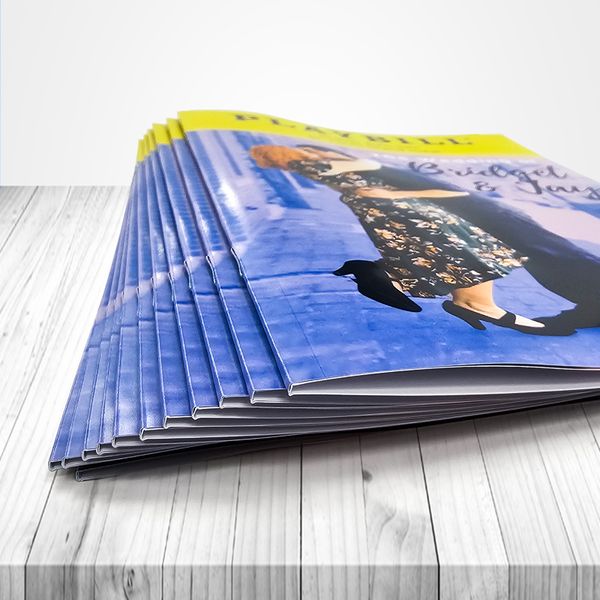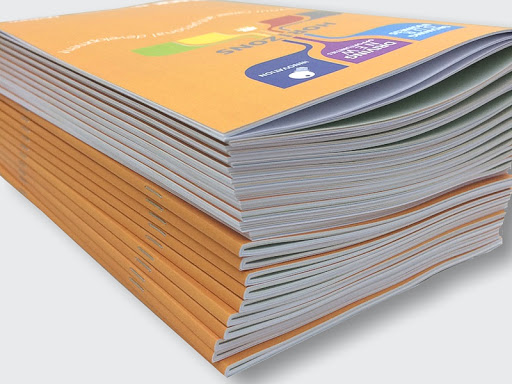The Crucial Guide to Recognizing Brochure Printing Options and Techniques
The process of brochure printing involves multiple factors to consider that can considerably affect the end product. From picking the ideal style and size to understanding the nuances of binding approaches, each selection plays a necessary function. Additionally, variables such as paper supply and printing techniques more affect the effectiveness of the pamphlet. As one browses these choices, it becomes imperative to realize exactly how they interconnect and what that suggests for the general outcome.
Comprehending Booklet Dimensions and styles
When considering pamphlet printing, comprehending the various styles and sizes offered is important for achieving the desired discussion. Brochures can be produced in many formats, consisting of saddle-stitched, spiral-bound, and perfect-bound, each offering distinct advantages. Usual sizes vary from conventional letter (8.5 x 11 inches) to smaller sized choices like A5 (5.8 x 8.3 inches), enabling flexibility based upon content and target audience.Selecting the appropriate size can affect both the layout and visitor engagement. Bigger dimensions might fit visually driven web content, while smaller styles might be extra portable and straightforward. Furthermore, the number of pages affects the choice of binding method, as thicker pamphlets might call for tougher bindings. Eventually, comprehending these aspects enables an extra customized technique, guaranteeing that the end product straightens with the desired message and aesthetic, enhancing the general efficiency of the interaction.
Selecting the Right Paper Stock
Binding Methods: Considerations and choices
When it comes to binding methods for brochures, numerous alternatives are available, each with unique benefits. Saddle stitch binding provides a cost-efficient option for thinner booklets, while excellent binding strategies supply an even more refined seek thicker magazines. Wire-O binding stands out for its resilience and simplicity of usage, making it suitable for documents that require flexibility.
Saddle Stitch Binding
Saddle stitch binding provides a cost-effective and useful option for assembling booklets, making it a prominent choice among authors and companies. This binding method involves folding sheets of paper in half and stapling them along the fold line, developing a well organized and neat look. Generally ideal for pamphlets with a lower web page matter, saddle stitching is excellent for publications, brochures, and educational products. The simplicity of this technique permits quick manufacturing and is often preferred for promotional items or short runs. However, it is important to keep in mind that saddle stitch binding might not appropriate for thicker brochures, as the spine might not hold up under raised weight. In general, it remains a trusted choice for many printing tasks.
Perfect Binding Methods
Perfect binding is a widely utilized technique that supplies a polished and specialist coating to booklets and magazines. This method entails gluing the pages with each other at the spine utilizing a solid adhesive, enabling a tidy edge and the capacity to hold a larger number of pages compared to saddle sewing. Perfect binding is specifically ideal for thicker pamphlets, such as magazines and yearly reports, where a strong, flat spinal column is desired. Additionally, it offers the choice for a published cover that can be designed to improve aesthetic allure. Considerations such as page matter, paper weight, and the planned use of the booklet ought to be taken into account, as they can influence durability and overall high quality.
Wire-O Binding Choices
Wire-O binding, known for its toughness and adaptability, offers an outstanding choice for booklets that require easy page turning and a professional appearance. This binding method utilizes a collection of steel loops that hold pages safely, permitting them to exist level when open. It is especially appropriate for directories, discussions, and guidebooks as a result of its durable nature. Wire-O binding is offered in different shades and diameters, accommodating various web page counts and thicknesses. Furthermore, it allows the incorporation of covers and tabs, enhancing the booklet's total visual. Considerations for Wire-O binding consist of the choice of wire shade, the dimension of the loops, and the level of personalization desired, all of which can profoundly affect the end product's look and capability.
Digital vs. Offset Printing: Which Is Best for You?
When picking a printing method for pamphlets, comprehending the distinctions in between digital and balance out printing is crucial. Digital printing utilizes contemporary technology to create top quality prints swiftly and economically, making it excellent for brief runs or tasks calling for quick turn-around times. It enables modification, offering the capacity to print on-demand with marginal waste.In contrast, counter printing is a traditional approach that masters generating large amounts with consistent quality. It entails transferring ink from a plate to a rubber covering, after that to the paper, which results in lively shades and accurate information. Nonetheless, balance out printing typically needs longer arrangement times and is more affordable for larger volumes.Ultimately, the selection in between digital and balance out printing depends upon task requirements, spending plan, and preferred amount. For little, time-sensitive jobs, digital could be the most effective choice, while balanced he said out might be better for larger, top quality productions.

Designing Your Brochure: Tips and Finest Practices
When designing a brochure, careful focus to layout, font style option, and shade use can substantially improve its performance. A well-structured layout overviews the visitor's eye, while suitable fonts guarantee readability and share the wanted tone. In addition, efficient use of color can evoke feelings and highlight key details, making the general layout extra impactful.
Selecting the Right Layout
Just how can one successfully choose the right format for a brochure? First, it is crucial to examine the booklet's objective and target market. A clean, organized design improves readability and engagement. Making use of a grid system can help in aligning components regularly, developing an expert look. Furthermore, incorporating visual power structure with differing sizes and positionings of images and message can guide the visitor's eye and stress essential details. It is also crucial to leave adequate white room, which avoids congestion and enables far better focus. Testing different layouts via mock-ups can provide understanding into how the style carries out in real-world circumstances, guaranteeing that the last product meets both aesthetic and practical requirements.
Selecting Suitable Font Styles
A well-chosen font style can greatly enhance the total layout of a pamphlet, enhancing the layout and reinforcing the content's message. The selection of fonts should consider readability, specifically for body text, as it guarantees the details comes to all readers. Sans-serif typefaces are often preferred for electronic styles, while serif font styles can provide a conventional feel in printed products. It's advisable to restrict font selections to 2 or three to maintain visual comprehensibility. In addition, typeface size plays an essential role; headings should be not overwhelming but distinctive, while body message ought to fit for analysis. When picking font styles, placement with the pamphlet's theme and target market is crucial for efficient communication and visual charm.
Effective Use Shade
Shade functions as an effective tool in pamphlet layout, guiding and forming understandings viewers emotions. It can stimulate sensations of excitement, calmness, or trust fund, relying on the shades picked. Developers ought to consider shade concept principles, making sure that the picked palette aligns with the booklet's message and target market. For example, using warm colors like red and orange can produce necessity, while cooler tones like blue and green foster tranquility.Additionally, comparison plays a vital function; corresponding shades can improve readability and aesthetic allure. Uniformity in shade use throughout web pages better enhances brand identity and cohesion. Eventually, efficient color implementation not just captures focus but likewise strengthens the booklet's function, making it a crucial facet of effective design.
Ending Up Touches: Coatings and Unique Impacts
While many take into consideration the content and layout of a booklet the most crucial aspects, the finishing touches, such as coatings and unique results, play a crucial duty in improving its general appeal. Coatings can give security and sturdiness, ensuring that the brochure holds up against damage. Matte coatings provide an advanced, non-reflective surface area, while shiny finishes can make shades appear even more attractive and dynamic. Special results, like embossing or foil stamping, add a responsive measurement that can create a memorable perception. These methods can highlight details areas, attracting attention to important details or producing aesthetic rate of interest. Additionally, UV finishing can supply a high-shine surface that boosts the total look.Together, these ending up touches not only enhance the booklet's aesthetic yet likewise communicate professionalism and reliability and attention to information, inevitably leaving a long-term effect on the visitor.
Expense Considerations for Pamphlet Printing
Recognizing the different expense factors to consider for booklet printing is vital for services and companies aiming to enhance their budget plans. Secret variables affecting costs consist of the option of binding, ink, and paper approaches. Better materials, such as exceptional paper or specialized inks, commonly increase the overall expenditure. In addition, the dimension and web page matter of the booklet play a substantial role; bigger booklets require more sources and time to produce.Another vital consideration is the printing method, whether electronic or balanced out, as each has its very own pricing structure and suitability for various amounts. Companies should also consider design prices, which can differ based upon intricacy and using professional solutions. Inevitably, delivery and handling costs can contribute to the total, especially for large orders. By assessing these aspects, organizations can make educated choices that straighten with their financial abilities while achieving the wanted top quality in their printed materials.
Frequently Asked Questions
What Are the Environmental Influences of Brochure Printing?
The environmental influences of booklet printing consist of deforestation from paper production, carbon emissions from transport, and waste browse this site generation from thrown out products - Booklet Printing. Lasting methods, such as utilizing recycled paper and environmentally friendly inks, can alleviate these effects
Exactly How Can I Make Certain Shade Precision in My Pamphlet?
To assure shade precision in a brochure, one should utilize calibrated screens, utilize specialist shade profiles, perform test prints, and pick top notch printing solutions that offer shade matching and proofing options for best outcomes.
What Is the Common Turn-around Time for Booklet Printing?
The typical turn-around time for brochure printing differs relying on the complexity and amount - Booklet Printing. Usually, it ranges from a few days to 2 weeks, influenced by elements such as printing techniques and ending up needs
Are There Minimum Order Quantities for Booklet Printing?

Can I Publish Brochures in Several Languages?
Publishing brochures in multiple languages is possible. Lots of printing solutions supply options for bilingual or multilingual designs, enabling for effective interaction. Mindful planning guarantees that create aspects fit numerous languages without endangering readability or looks. Furthermore, factors such as paper stock and printing strategies additional affect the performance of the booklet. When considering pamphlet printing, recognizing the various layouts and sizes readily available is vital for achieving the preferred discussion. When choosing a printing approach for brochures, recognizing the differences in between digital and counter printing is essential. Additionally, the size and page matter of the booklet play a considerable duty; bigger booklets need more sources and time to produce.Another essential factor to consider is the printing technique, whether digital or balanced out, as each has its very own rates websites framework and suitability for various amounts. The ecological influences of booklet printing consist of logging from paper production, carbon exhausts from transport, and waste generation from thrown out materials.